Richard Cribb
He does monologues
- Joined
- Nov 5, 2003
- Messages
- 4,291
And so, finally the second part. My apologies for delays, but sometimes my dance-card is quite full, and then certain things have to be put on ice for a while. But enough about that, here it is, I will try to post part three before Christmas.
As usual any comments, constructive critique and questions are welcome.
A WAR AND THE CONSEQUENCES THEREOF.
When the world is young, everything must be learned. Nothing is fixed yet, everything can still change.
The humans learn about love and friendship, but they also learn about hate and deceit.
In these mythic times a man can have many wives, and a woman also doesn't have to keep to one man. This is how it is among the humans - and the gods are no exception.
Odin is married to Frigg. With her he begets the son Balder.
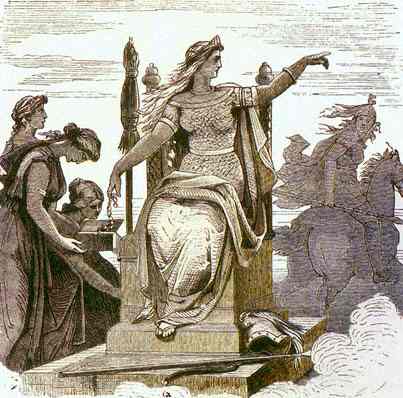
Frigg
With another female, Jord, he begets the son Tor.
And with the giant woman Grid, the son Vidar. Yes, the giants might be enemies, but the sexual allure of their women might sometimes be too great a temptation...
And sometimes friendships with them are possible as well. Like with Loki, the son of the giant Fårbaute. Loki becomes Odin's friend and settles down in Asgard
Odin has created a world he doesn't understand. So to learn more he becomes a wanderer. In many a disguise he walks around in the world, talking with animals and people, witches and giants.
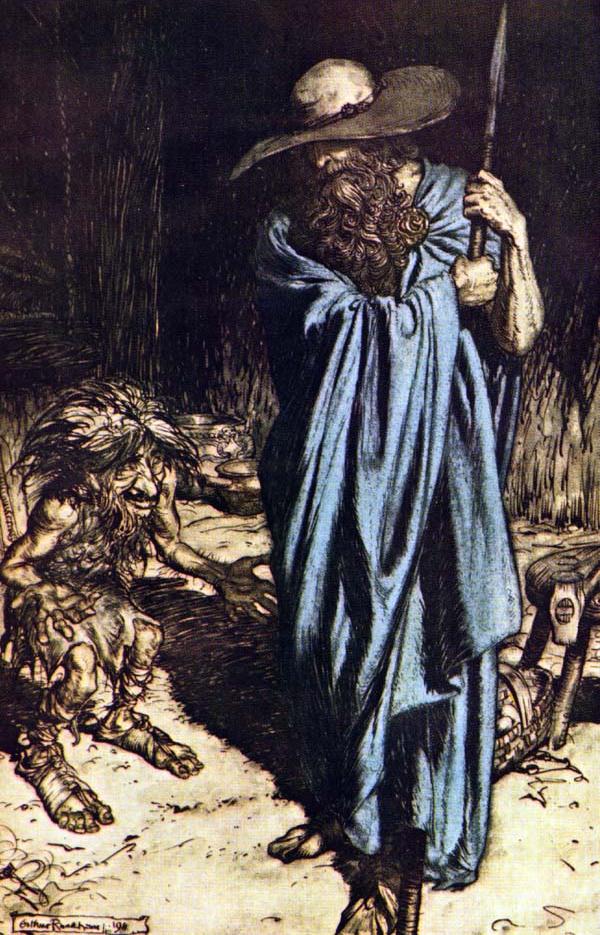
Odin the wanderer
As mentioned, there are other gods in the world than the Aesir, there are those living in the fortress Vanaheim.
They call themselves Vanir. And they seem to be more connected to the plants and animals than the Aesir are.
They help the farmers, and they also have friendly relations with the elves.
Even if they seem peaceful, Odin doubts that there is room for two families of gods in the world.
He realizes that there might come a time when the Aesir and Vanir will stand up against each other, deciding which side should have the hegemony. He also realizes that knowledge is power.
So his travels lead him to Jotunheim. Rumours say that, Mimir, the wisest of all beings resides there. It is dangerous, but the brave Odin doesn't shy away from it, and he succeeds in finding Mimir, and revealing the secret of his knowledge.
It is a well. The water in Mimir's well is such that every time one drinks it, one becomes a bit wiser.
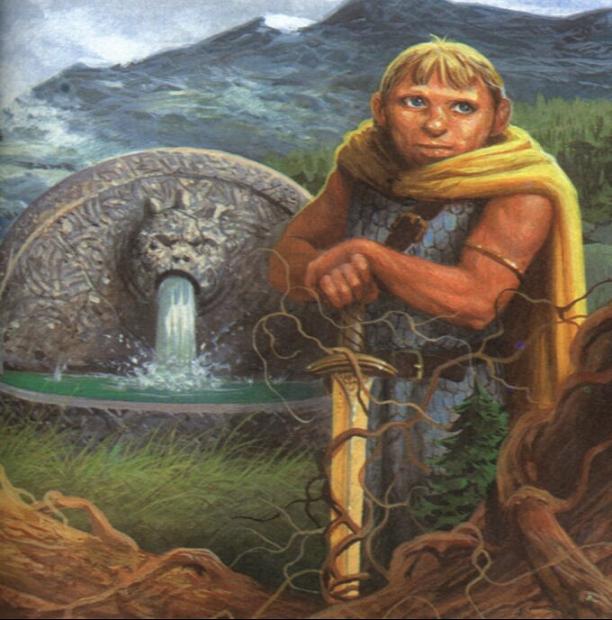
Mimir and his well
At first Mimir denies Odin to drink from it. Threats and promises are to no avail. Odin is still a young god, not yet Allfather, and not secure in his own strength.
But finally Mimir names his prize. If Odin will give him one of his eyes, he can drink as often and as much as he wants.
Such is Odin's thirst for knowledge that he immediately tears out an eye, bends down and starts to drink.
Now Mimir understands who he has in front of him. And being wise, he understands what will become of Odin. So he decides to become his friend and counsellor.

Gullveig
And then one day a great war breaks out between the Aesir and the Vanir.
It starts with the visit of Gullveig in Asgard. Gullveig might have been one of the Vanir, or at least related to them.
As might be deduced from her name (gull = Norse for gold), Gullveig loves gold. To the point of obsession. She talks of nothing else.Her eyes are filled with greed. And so persuasive is she that the Aesir starts to be carried away themselves.They realize that she is dangerous, and that the world would be a better place without her. So they resort to strong measures. First they pierce her with spears. Then three times they burn her in a magical fire. Each time she is reborn.
They are unable to destroy her because she is a master of black magic, something the Aesir have not mastered.
The Vanir, otherwise peaceful, demand reparations for these acts. Instead the Aesir declare war.
In the beginning, the Vanir get the upper hand, using magic. But the Aesirs are able to strike back. The war leads to huge losses on both sides.
Finally the fighting parties realize that this might get out of hand. Negotiations are started. Finally peace ensues, granting the Vanir equal rights.
To make sure that the peace will last, the two parties make an exchange. To Asgard comes Njord, one of the most prominent Vanir. He comes with his children Frey and Freya while Høner and Mimir go to Vanaheim.
Both parties also want to show how important the peace is for them so they honour their new inhabitants. The three Vanir are granted equal rights as the Aesir, while the Vanir give Høner the status of chief.
Through the three Vanir the Aesir learn a lot. The Vanir have some strange customs. It is still common among them that siblings marry. The mother of Frey and Freya is for instance Njord's sister.
They also learn about their magic; seid.
Njord knows many things. He controls the wind, the sea and the fire. He can give luck to fishermen and hunters and he can also bring wealth.
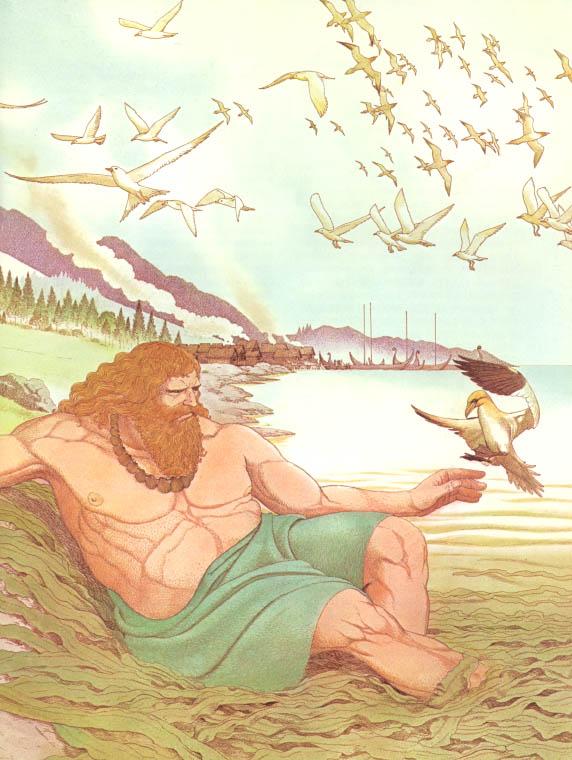
Niord
Frey has even greater powers. He can create any weather he wants. He rules over everything growing. He is also the bringer of happiness and peace.

Frey
But the mightiest is the beautiful Freya. When she cries, her tears are made of gold.She is not only a master in magic, but even more the goddess of love. And in the universe, no power is greater than love.
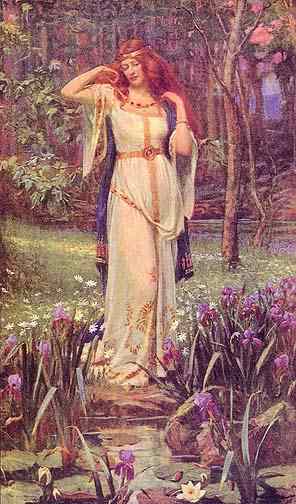
Freya
Odin is impressed by the knowldge those three possess. But equally impressed is the giant son Loki with whom Odin has mixed blood.
Loki is not one who can be trusted. He is handsome. But he is also cunning and even malicious. He has a way with twisting words to turn everything in his favour. And while he already knew some magic, the new knowledge he aquires makes him dangerous.

Loki
And while Loki has Odin's friendship there is another one that from the beginning will opposed to him, Odin's son Tor.
Tor does not possess Odin's wisdom. He is much simpler, easy to trick, and has difficulties to control his angry temper. However he also has a strict sense of justice, and he is the champion of the weak.
Every time the giants break into Midgard, it is Tor that comes to the human's rescue. For he is huge, brave and strong. And when he puts on his belt, his strength is doubled.The giants fear Tor, and rightly so.

Tor
Tor hates deceit. Probably this is why Loki finds pleasure in trying to hurt exactly him. One of his pranks will have a great importance for the Aesir.
But more about that next time.
As usual any comments, constructive critique and questions are welcome.
A WAR AND THE CONSEQUENCES THEREOF.
When the world is young, everything must be learned. Nothing is fixed yet, everything can still change.
The humans learn about love and friendship, but they also learn about hate and deceit.
In these mythic times a man can have many wives, and a woman also doesn't have to keep to one man. This is how it is among the humans - and the gods are no exception.
Odin is married to Frigg. With her he begets the son Balder.

Frigg
With another female, Jord, he begets the son Tor.
And with the giant woman Grid, the son Vidar. Yes, the giants might be enemies, but the sexual allure of their women might sometimes be too great a temptation...
And sometimes friendships with them are possible as well. Like with Loki, the son of the giant Fårbaute. Loki becomes Odin's friend and settles down in Asgard
Odin has created a world he doesn't understand. So to learn more he becomes a wanderer. In many a disguise he walks around in the world, talking with animals and people, witches and giants.

Odin the wanderer
As mentioned, there are other gods in the world than the Aesir, there are those living in the fortress Vanaheim.
They call themselves Vanir. And they seem to be more connected to the plants and animals than the Aesir are.
They help the farmers, and they also have friendly relations with the elves.
Even if they seem peaceful, Odin doubts that there is room for two families of gods in the world.
He realizes that there might come a time when the Aesir and Vanir will stand up against each other, deciding which side should have the hegemony. He also realizes that knowledge is power.
So his travels lead him to Jotunheim. Rumours say that, Mimir, the wisest of all beings resides there. It is dangerous, but the brave Odin doesn't shy away from it, and he succeeds in finding Mimir, and revealing the secret of his knowledge.
It is a well. The water in Mimir's well is such that every time one drinks it, one becomes a bit wiser.

Mimir and his well
At first Mimir denies Odin to drink from it. Threats and promises are to no avail. Odin is still a young god, not yet Allfather, and not secure in his own strength.
But finally Mimir names his prize. If Odin will give him one of his eyes, he can drink as often and as much as he wants.
Such is Odin's thirst for knowledge that he immediately tears out an eye, bends down and starts to drink.
Now Mimir understands who he has in front of him. And being wise, he understands what will become of Odin. So he decides to become his friend and counsellor.

Gullveig
And then one day a great war breaks out between the Aesir and the Vanir.
It starts with the visit of Gullveig in Asgard. Gullveig might have been one of the Vanir, or at least related to them.
As might be deduced from her name (gull = Norse for gold), Gullveig loves gold. To the point of obsession. She talks of nothing else.Her eyes are filled with greed. And so persuasive is she that the Aesir starts to be carried away themselves.They realize that she is dangerous, and that the world would be a better place without her. So they resort to strong measures. First they pierce her with spears. Then three times they burn her in a magical fire. Each time she is reborn.
They are unable to destroy her because she is a master of black magic, something the Aesir have not mastered.
The Vanir, otherwise peaceful, demand reparations for these acts. Instead the Aesir declare war.
In the beginning, the Vanir get the upper hand, using magic. But the Aesirs are able to strike back. The war leads to huge losses on both sides.
Finally the fighting parties realize that this might get out of hand. Negotiations are started. Finally peace ensues, granting the Vanir equal rights.
To make sure that the peace will last, the two parties make an exchange. To Asgard comes Njord, one of the most prominent Vanir. He comes with his children Frey and Freya while Høner and Mimir go to Vanaheim.
Both parties also want to show how important the peace is for them so they honour their new inhabitants. The three Vanir are granted equal rights as the Aesir, while the Vanir give Høner the status of chief.
Through the three Vanir the Aesir learn a lot. The Vanir have some strange customs. It is still common among them that siblings marry. The mother of Frey and Freya is for instance Njord's sister.
They also learn about their magic; seid.
Njord knows many things. He controls the wind, the sea and the fire. He can give luck to fishermen and hunters and he can also bring wealth.

Niord
Frey has even greater powers. He can create any weather he wants. He rules over everything growing. He is also the bringer of happiness and peace.

Frey
But the mightiest is the beautiful Freya. When she cries, her tears are made of gold.She is not only a master in magic, but even more the goddess of love. And in the universe, no power is greater than love.

Freya
Odin is impressed by the knowldge those three possess. But equally impressed is the giant son Loki with whom Odin has mixed blood.
Loki is not one who can be trusted. He is handsome. But he is also cunning and even malicious. He has a way with twisting words to turn everything in his favour. And while he already knew some magic, the new knowledge he aquires makes him dangerous.

Loki
And while Loki has Odin's friendship there is another one that from the beginning will opposed to him, Odin's son Tor.
Tor does not possess Odin's wisdom. He is much simpler, easy to trick, and has difficulties to control his angry temper. However he also has a strict sense of justice, and he is the champion of the weak.
Every time the giants break into Midgard, it is Tor that comes to the human's rescue. For he is huge, brave and strong. And when he puts on his belt, his strength is doubled.The giants fear Tor, and rightly so.

Tor
Tor hates deceit. Probably this is why Loki finds pleasure in trying to hurt exactly him. One of his pranks will have a great importance for the Aesir.
But more about that next time.











